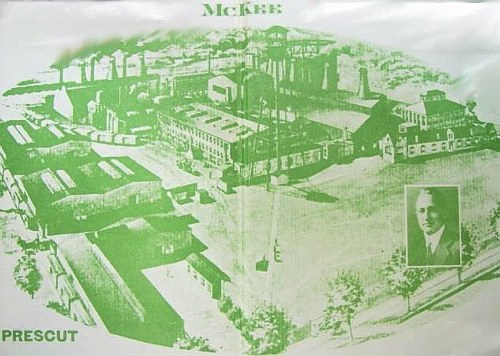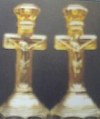McKee Glass - Early History

A BRIEF (early) HISTORY OF THE McKEE GLASS COMPANY
Condensed from The Complete Book of McKee Glass by Sandra McPhee Stout (copyright 1972)
In the trade it was said that the words McKee and glass have been synonymous for over a hundred years. McKee Glass Company started operation as McKee and Brothers Glass Works, manufacturers of crystal glassware, in 1853. It started as a large concern and always maintained a large business in production and decorating and consequently was always ready and able to handle volume business.
The factory was situated originally in Pittsburgh, PA on the South Side, from 1853-1888.
Later, following development of extensive natural gas fields, the company moved to Westmoreland County and settled in a town which the workers at the plant formed. The town was named Jeannette (after Mrs. McKee), and was founded by H. Sellers McKee, the owner of the McKee plant. Jeannette is located approximately 27 miles east of Pittsburgh.
Wisdom of the move was further proven when abundant natural gas was no longer available, since Westmoreland County had the largest soft coal mines in the country. McKee built up-to-date producers, bought a fleet of coal cars, and was able to keep in full operation during both world wars.
Located on the main line of the Pennsylvania Railroad, the company enjoyed unexcelled facilities for receiving raw material and shipping finished products.
The town of Jeannette continued to expand and by 1929 had a population of over 18,000 in the area proper. The town also grew in glass operations and by 1929 boasted eight different glass manufacturing plants. The city became world renowned for its glass and has been appropriately nicknamed “Glass City.”
By September of 1904, the third furnace was running and that plant was producing its high grade ware. The new line in the PRESCUT series, “Wortec”, was introduced. Heavier, more brilliant in metal, and more elegant in its distinctive design than the Aztec and Toltec patterns which had become so famous nine months earlier.
By 1907, the Tec table lines were commanding a substantial share of the market. A new Tec pattern, called Fentec was released for the fall trade of 1907.
The McKee factory passed from the McKee family when the National Glass Company was formed, although they continued to operate under the McKee Glass Company name. National Glass Company controlled nineteen factories and early in its history dissensions developed with the management, bringing about disassociations of the ablest men to begin competitive concerns.
The National Glass Company leased the McKee works at Jeannette, one of the finest plants it possessed, to the McKee-Jeannette Glass Company, a new corporation, with a capital of $250,000.
Many companies were able to succeed after breaking away from direct control of the National Glass Company. By 1908, the three largest plants, the Cambridge Glass Company, the Indiana Glass Company, and the McKee-Jeannette Company had filed excellent financial reports.
The Company was not without problems, In 1909, the Circuit Court of PA handed down a decision in the matter of the suit of the J.C. Fry Glass Company against the McKee-Jeannette Glass Company for the infringement of patents of the first named company relative to the manufacturer of figured blanks for glass cutting. The court held that the defendants had infringed and enjoined them from further use of the patents in question.
In 1916, the United States Glass Company and the Duncan & Miller Glass Company had granted the McKee Glass Company and the Cambridge Glass Company licenses to manufacture certain pressed, figured, and cut lines under their patents. This meant that the first two concerns would and did receive a royalty on business of the McKee Glass Company on these lines. Other glass factories also may have been granted licenses to manufacture items from these patents.
Every year from its beginning in 1853, the McKee plant had been the leader in producing new and improved lines, not only in the high quality tableware, but in a great multiplicity of unusual and popular selling items, until they were eventually putting out many thousands of different articles of glassware in plain, decorated and cut, in both crystal and colors.
Footnote: As molds move through the industry, this is a great place to interject the fact that at some point in time, the Fenton Factory purchased some original McKee molds. They may still be utilized from time to time for production?
D/D Fry - 4/05



Should you care to contact the Frys, their email address is:
Search Our Sites
back to Carnival Glass 101
Our other sites you may enjoy:
Everything you EVER wanted to know about Indiana Glass
Great Reference for Newer Carnival Glass.
Complete Glassware Catalogs Available to Download
Questions? Comments? Suggestions? Broken Links? Corrections?
Your Friendly Webmaster is here to help!
